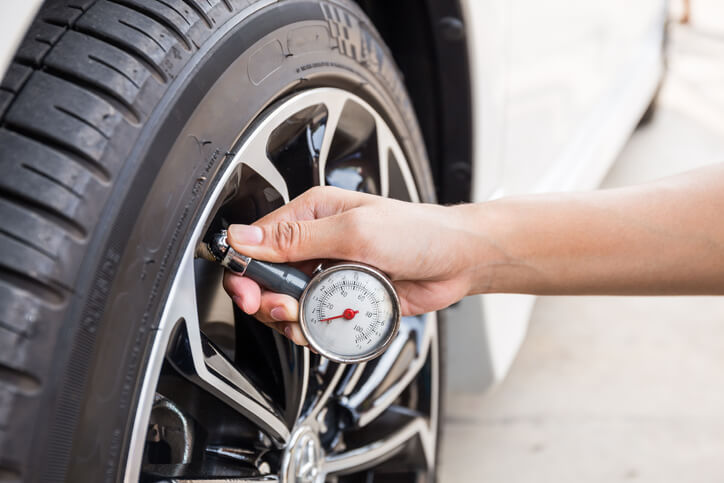Purchasing an electric or hybrid vehicle isn’t the only way to green driving. Simple changes to your vehicle and driving habits can help reduce pollution. Learn some of the easiest ways you can help make your car greener and safer, while saving some money at the pump.
Green Driving Tips

Changes to Your Car to Improve Fuel Efficiency
The following alterations and repairs can help make your car greener. If you are not comfortable making these alterations on your own, ask a mechanic to make them at your vehicle’s next servicing.
Check Your Tire PSI
The pressure in your tires impacts your fuel economy.
On average, every 1 PSI drop reduces gas mileage by 0.2%. Tires inflated to the correct PSI can increase fuel economy by 0.6 to 3%.
Never inflate your tires to the maximum PSI printed on the tire. Instead, look for your car’s tire PSI sticker. You can find this in the driver-side door jam or the owner’s manual. This sticker has the correct PSI for your vehicle’s tires. Note that the front and back tires may have different optimal pressure levels.
Use the Correct Oil
Be sure to check what grade motor oil your vehicle needs.
Using the correct oil in your vehicle can improve your fuel economy by 1 to 2%. The wrong oil can lower your gas mileage in an equal amount. Don’t use “high-performance” oil that isn’t a match for your vehicle. Also, use “energy conserving” oil when possible. Energy conserving oil contains friction-reducing additives. These additives can help improve your vehicle’s fuel economy.
Get the Junk Out of Your Trunk
Added weight in your car can decrease your vehicle’s fuel economy.
An extra 100 pounds of cargo can reduce your vehicle’s fuel economy by 1%. Rooftop cargo containers and racks can reduce fuel economy even more, sometimes by as much as 25%. Be sure to remove roof racks and storage containers when not in use or switch to a rear-mount cargo box. Rear-mount cargo boxes still reduce fuel economy, but only by 1 or 2%.
Should You Change Your Air Filter?
It is often recommended that you change your air filter to increase fuel efficiency.
If your car predates the 1980s, then it most likely has a carbureted engine. If it does, changing your air filter can increase fuel efficiency and acceleration. Most cars manufactured after the 1980s have fuel-injected, computer-controlled engines. Changing the air filter in these cars may improve acceleration but not gas mileage.
Driving For Better Fuel Efficiency
Simple changes to driving habits can improve your vehicle’s fuel efficiency. Most of these changes will also help increase safety for you and others on the road. Best of all, you don’t need a mechanic to start reaping the benefits.
Don’t Drive Aggressively
Aggressive driving is operating a vehicle in an unsafe and erratic way.
This includes fast acceleration, short stopping and revving your engine. Aggressive driving can lower your gas mileage by as much as 30% when driving on the highway. If you drive aggressively in stop-and-go traffic, you may see a reduction in fuel economy by as much as 40%.
You can break the bad habit of aggressive driving. Here are a few tips:
- Maintain three seconds of distance between your vehicle and the vehicle in front of you (or more if the weather is bad). If the vehicle in front of you passes a tree, it should take three seconds before you pass that tree. This will help ensure that you have enough time to adjust speeds or stop in response to the driver in front of you.
- Try to roll to stop signs and red lights. Don’t continue accelerating and then stomp on your brakes. This will wear out your brakes much sooner and reduce your miles per gallon.
- Install a driver feedback device. These devices track your driving habits and can help you improve your driving behavior–and therefore, your fuel economy.
Use Cruise Control
You can help improve your gas mileage by using cruise control on long stretches of driving.
Cruise control is ideal if you’re traveling on the highway for a long distance and there are very few cars around. It’s not recommended to use cruise control on hilly terrain. This is because the vehicle will have trouble navigating the hills and it will waste more fuel.
Some newer vehicles are being equipped with updated cruise control devices. These devices maintain distance between your car and the car in front of it. This will slow down your vehicle as it gets closer to the vehicle in front of you. The device will then adjust to and maintain the same speed as the vehicle in front of you.
Drive 50 Miles per Hour
Fuel economy plummets when your vehicle accelerates past 50 to 60 mph.
For each 5 mph over 50 mph that you drive, you’ll pay, on average, $.16 more per gallon of gas. Speeds below 50 mph all seem to have the same fuel efficiency. Driving 40 mph on back-roads may help you save on gas compared to driving 65 mph on the highway.
Roll the Windows Down or Use the AC?
There is much debate over the fuel efficiency of rolling your windows down or turning on the AC.
Some people say rolling your windows down and turning the AC off helps improve mileage. This is because your vehicle is not using energy to run the AC. Other people say it’s best to roll the windows up and turn the AC on. Doing this reduces drag. Some people will say to keep windows down and AC off at low speeds and turn the AC on and roll the windows up at high speeds.
What Is the Best Green Driving Option?

A test performed by General Motors and SAE gave a conclusive answer. The test found that AC off and windows down is always more fuel-efficient than windows up and AC on. It didn’t matter what speed the vehicle was driving at. Windows up and AC off, however, is still by far the most fuel-efficient option for driving.
How Fuel Efficient Is Your Car?
Find and compare the fuel economy on cars from 1984 to the present at fueleconomy.gov.
Driving safely and spending less money at the pump are two of the benefits of making your car greener. You can also enjoy knowing that you’re helping to reduce CO2 emissions and pollution. Talk to your mechanic about ways to increase your vehicle’s fuel efficiency and be sure to practice fuel efficient driving habits.